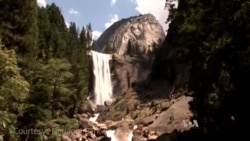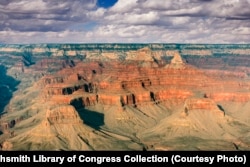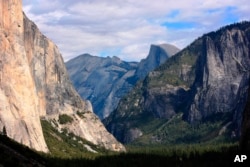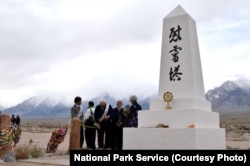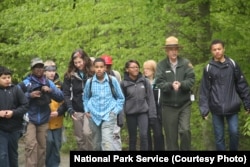More than 300 million people from around the world visit America’s national parks each year.
They visit beautiful places like the Grand Canyon and Yosemite. They walk among the ancient giant sequoia trees and watch wolves, bison and bears in their natural habitats.
They are all managed by the U.S. National Park Service. This year it is celebrating its centennial, or 100th anniversary.
Jonathan Jarvis is the National Park Service Director. Recently, he spoke to VOA about his time with the service.
“For the last 100 years, the National Park Service has been charged by the U.S. government to manage the very best of America; the very best places that represent both our natural and cultural heritage. So, to be part of this organization and to be in the directorship is really a lifelong dream for me.”
He has worked at the park service for 40 years, and been the director since 2009.
“I like to say the National Park Service is the only federal agency with the responsibility to ensure the public actually has fun! So we have a lot of places that are there for the enjoyment of the American people, and visitors from around the world.”
Called the country’s national treasures, these parks are found in every state. They cover over 32 million hectares from Guam to the Virgin Islands to Alaska. There are 412 sites in all.
Not Just Beauty: Lessons Learned Too
But they are not just places of wild nature. The national parks include thousands of historic buildings, presidential homes, monuments and Civil War battlefields. They tell the story of the United States of America.
The director says the parks are not just about seeing their beauty.
“We want you to learn something, to take something away. Whether it’s to learn about nature or plate tectonics or climate change, but also about history.”
Sometimes those history lessons are difficult ones about the darker side of America.
Jarvis talks about the Manzanar National Historic Site in California. This is the place that tells the story of the internment of Japanese-Americans in military-like camps during World War Two. He explains that Japanese-Americans were held in the camps by order from President Franklin Roosevelt when the U.S. was at war with Japan.
“Over 100,000 Japanese-Americans were rounded up at bayonet point and put into prison camps for multiple years during the war just because of their ethnicity. The Park Service has been charged with telling that kind of story."
Jarvis says it is “an honor” to serve as the director. It is a big job. The agency has 22,000 employees and gets help from another 400,000 volunteers. He says being in charge of “incredible places” is the “best job in the government.”
Those incredible places are full of action—fires, volcanoes and floods. He says there are also activities around the First Amendment of the U.S. Constitution—freedom of speech. The parks also participate in activities around the Confederate flag used by the south in the Civil War, and LGBT rights.
Dealing with Climate Change
The national parks hold some of the country’s most beautiful natural spaces. One thing the park service must deal with, however, is climate change. The parks are federally protected, but that does not shelter them from the effects of warming temperatures.
Jarvis gives some examples. Like the glaciers -- the large bodies of ice on slopes -- in Glacier National Park. He says they will be “gone within 20-25 years.” He adds that the wildfires in the national parks and other public lands are burning “at least a month longer,” than in years past.
Because of climate change, he says, “the forests are not even coming back the same way.”
“We’re seeing species being forced to migrate and not necessarily having the corridors to connect between parks and protected areas across the landscape.”
Park Service’s Second Century
Heading into its second century, Jarvis says the new national parks will be “more representative” of women and minorities in the U.S.
He says there are several key goals for the parks future. One of those goals, he says, is “battling to protect these key natural resources.”
“I hope that the Park Service thrives in its second century -- that it is established on a sound foundation of financial support. But really the key is the public support. That the public still views the National Park Service as essential.”
I’m Anne Ball.
Julie Taboh wrote this story for VOA News. Anne Ball adapted it for Learning English. Hai Do was the editor. We want to hear from you. Write to us in the Comments Section and visit us on our Facebook page.
_____________________________________________________________
Words in This Story
centennial – n. the one hundredth anniversary of something
plate tectonics – n. the theory that Earth’s outer shell is divided into several plates that move over the surface of the Earth
bayonet – n. the knife-like point at the end of a rifle
ethnicity – n. group of people who belong to a particular race or share a culture
LGBT – short cut phrase. stands for lesbian, gay, bisexual and transgender
migrate – v. to move from one place to another to live
corridor – n. a long narrow passage in a building or piece of land
thrive – v. to do well
essential – adj. extremely important or necessary



